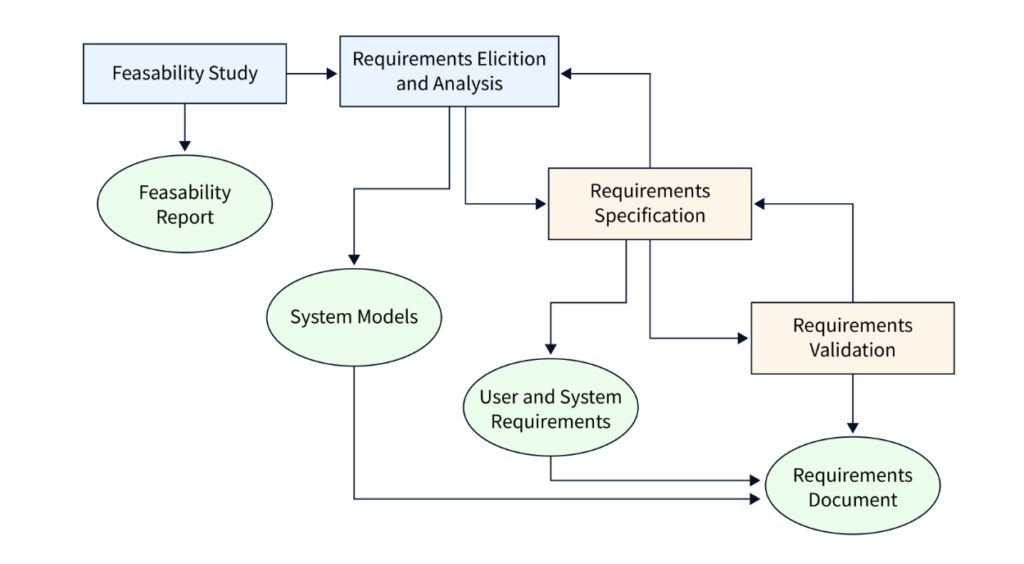Table of Contents
In this article, you’ll learn about What is Requirement Engineering, Feasibility Study, Requirement Elicitation and Analysis, Software Requirement Specification, Software Requirement Validation, Software Requirement Management and more.
What is Requirement Engineering
Requirement engineering is the process of defining, documenting, and maintaining requirements in the engineering design process. Requirements engineering provides an appropriate mechanism to understand what the customer desires, analyze the need for feasibility, negotiate a reasonable solution, specify the solution clearly, and validate the specifications, keeping track of requirements as they evolve into a running system. Thus, requirement engineering is the orderly application of proven principles, methods, tools, and notation to describe the intended behavior and constraints of a proposed system.
Requirement Engineering Process
Requirement Engineering is a fundamental process in software development that focuses on understanding, documenting, validating, and managing the needs and constraints of stakeholders to ensure the successful development of a software system. The process usually consists of various steps meant to ensure that the final software product will meet user and stakeholder needs and expectations, which are as follows:
- Feasibility Study
- Requirement Elicitation and Analysis
- Software Requirement Specification
- Software Requirement Validation
- Software Requirement Management

Feasibility Study
This the first stage of the requirement engineering process. It involves evaluating the feasibility of the proposed software project. The main aim, in this case, is to see if the project is viable both technically, economically, and operationally. Amongst the aspects considered at this stage are:
- Technical Feasibility: Is the system envisioned developable with available technology and resources?
- Economic Viability: Is the project viable in terms of cost and benefits?
- Operational Feasibility: Will the system be compatible with an existing organizational structure and process?
Elicitation and Analysis of Requirements
This is where the requirements are elicited and analyzed from all concerned stakeholders, including users, customers, and domain experts. This is meant to understand the needs of the system in order to formulate specific software requirements. This henceforth may involve a number of techniques such as:
- Interviews: A personal dialogue with stakeholders concerning information.
- Surveys: Distributing questionnaires to collect opinions and preferences.
- Workshops: This involves collaborative group sessions to brainstorm and elicit requirements.
- Observation: Actively observing users to understand their workflow and needs.
- Prototyping: An early version of software is developed to obtain feedback.
The various requirements collected are then analyzed for completeness, consistency, and feasibility. The conflicts and ambiguities are cleared, and the requirements are sorted into categories based on their characteristics, such as functional and non-functional.
Software Requirement Specification
In this phase, all the various requirements collected and analyzed are documented formally. The SRS document is prepared, which acts like a blueprint for the development process. The SRS comprises the following:
- Functional Requirements: Descriptions of what the system should do in terms of specific functions and features.
- Non-functional Requirements: Constraints and qualities the system should have, including performance and security.
- User Interfaces: These define how users will interact with the system. Data Requirements: Descriptions of data to be stored, processed, and managed by the system.
Software Requirement Validation
It is the process of verifying documented requirements to accurately reflect the needs and expectations of stakeholders. The intent is to catch errors and misunderstandings early before development starts. The following are techniques used for requirement validation:
- Reviews: Expert reviews and walkthroughs for finding out issues in the SRS.
- Prototyping: Develop a functional model of the software to confirm requirement needs.
- Simulation: Simulating the software’s behavior to test its alignment with requirements.
Software Requirement Management
Requirement management is an ongoing process that involves maintaining and tracking changes to requirements throughout the software development lifecycle. It includes activities such as:
- Version Control: Managing different versions of the requirements document.
- Change Control: Managing and documenting changes to requirements and their impact.
- Traceability: Establishing links between requirements and design, implementation, and testing.
- Prioritization: Assigning priorities to requirements to guide development efforts.
- Communication: Ensuring stakeholders are informed about changes and updates to requirements.